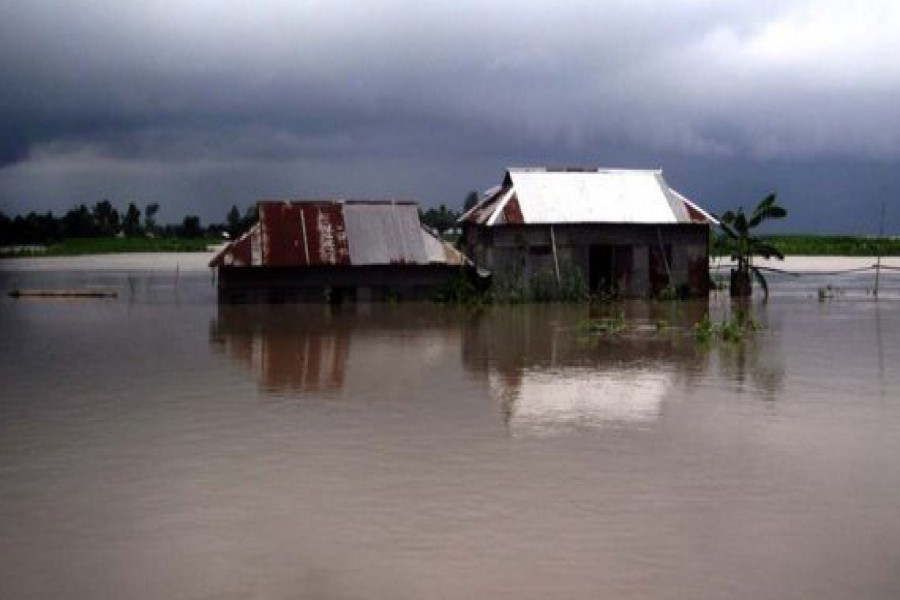Rural households in Bangladesh are at present in sudden shocks following flood that has adversely affected approximately 40 districts. Just a few months back, an untimely flash flood had created havoc in haor (wetland) basin putting people in peril. As we all know, rural households move up and down the poverty line mostly on account of natural and man-made disasters they have to encounter. Social scientists argue that besides producing immediate hardships, these shocks also generate long-term adverse consequences in terms of asset and income loss and rising expenditures. Both the nature of shocks and coping mechanism go together to determine how people succeed or fail in coming out of poverty.
S.R Osmani (of Ulster University) and others have succinctly delved deep into the dynamics of shocks and coping mechanism in rural life. These are apparently connected with a number of conundrums 'ranging from vagaries of nature and uncertainties of the market to personal calamities of myriad types'. Customarily, as they put, shocks are classified as 'covariate' or 'systematic' shocks and 'idiosyncratic' shocks. The former tends to affect a large number of people sharing common characteristics such as floods, cyclones, and drop in yield or price of a staple crop. By contrast, idiosyncratic shocks are peculiar to a person or a household such as death or prolonged illness of the major income earner of the family. Impression about the distinction is important to draw policy conclusion: a standard insurance policy may suit the former while it is unsuitable for the latter. From the point of view of impacts of shocks on the household economy and the consequent coping strategy, a more useful way is to look at the nature of impact on the household economy namely, asset, income and expenditure shocks. For example, death of a livestock is an asset shock, loss of job an income shock and treatment of illness an expenditure shock.
Coping strategies are also multiple depending on the nature of shocks and the resources available to the households. In this column, a la Osmani and others, we classify them as erosive and non-erosive coping strategies. Erosive strategy involves immediate erosion of the household asset base, while non-erosive strategy keeps the asset base in tact, at least in the short-run. For example, sale of land or other assets or drawing down accumulated savings is erosive strategy. "An erosive strategy with long-term consequences would involve stopping children from going to schools either to save educational expenses or to use children's labour for the purpose of earning additional income. In either case, it would entail a loss of future human capital". Examples of non-erosive strategy include borrowing, drawing upon reciprocal support system, social safety nets etc.
The incidence of shocks, as revealed by an earlier census of households in 62 villages, and in response to a question whether households have faced any shock during the last three years preceding the period of the census (2010-2013), shows that about 14 per cent of households reported that they have faced shocks. Apparently, the ratio is much lower than shown by earlier studies mentioned above. However when households are classified by district and village, the difference narrows down. We find that in villages of 8 districts, the incidence hovers around 33-56 per cent (highly vulnerable); in 6 other districts, the incidence is 20-28 per cent (moderately vulnerable). Taken together, we can possibly argue that 25-40 per cent of households have faced shocks of any kind during 2010-2013 period. Again, about 44 per cent of the total shocks are income shocks followed by expenditure shocks (about 40 per cent), and asset shocks (16 per cent). Income shocks are dominated by natural calamities such as flood/heavy rains and cyclone/tornado. The expenditure shock arises predominantly from health hazards such as treatment of illness. Many migrants are deceived by the agents to put them in peril. Finally, among the asset shocks, loss of livestock is at the top.
The poor may not necessarily be more vulnerable than the non-poor as the uneducated or landless ones are not more vulnerable than their respective counterparts. It is true that the consequences of any given shock may be more devastating for the poor, but as far as frequency of shock is concerned, they may not perform worse. Osmani and others (2013) observed that the incidence is likely to rise with the standard of living e.g., well-off group suffering from the highest incidence of all types of shocks and the relatively more educated suffering most from shocks (standard of living effect).
The Research and Evaluation Division (RED) of the Bangladesh Rural Advancement Committee (BRAC) has produced an assessment paper on the recent flood-led havoc in haor areas. The preliminary observations seem to support the theoretical discussions on shocks and support as outlined before. First, the flash flood was a 'co-variate' or 'systematic' shock affecting a large number of people and areas in greater Sylhet district. Second, the household-level data tends to show that affected households faced both erosive and non-erosive strategy of coping with the crisis. Included among erosive strategy are sale and destruction of assets (such as cows, ducks and withdrawing children from schools to put to work), depletion of household savings etc. The income shock comprised loss of labour man-days in agriculture and in other activities. The expenditure shock came from extra expenses on treatments following water-borne diseases. By and large, the total 'quantifiably estimable' losses on account of these stood at roughly Tk. 60 billion.
The writer is a former Professor of Economics at
Jahangirnagar University.
[email protected]

- Monday, 25 November 2024 |
- Today's FE |
- e-Paper |
- Beta Website

